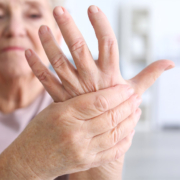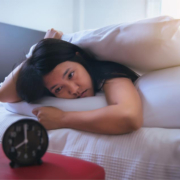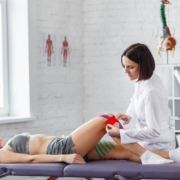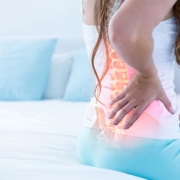8 Ways for Women to Lower Their Chances of Developing Arthritis
According to the CDC, more than 50 million Americans have chronic joint pain or arthritis.
Unfortunately, this chronic pain condition is more common in women.
Anatomy is a contributing factor. Because women have wider hips, there is more stress on their outer knees.
Also, women have less knee cartilage than men, so wear and tear come faster.
But…
Many women don’t ever develop arthritis, and there are many ways to lower the risk. Here are our tips:
1. Eat healthier and eat less.
Obesity is the number one arthritis risk factor for men and women. Every extra pound of weight adds four pounds of pressure on the knees and hips.
Try to eat more nutritious foods high in soluble fiber like citrus fruits, barley, chia seeds, and legumes.
Foods with soluble fiber make you feel full for longer than processed foods that are low in fiber.
2. Reduce repetitive motion tasks.
Repetitive motion is a significant risk factor for osteoarthritis. Office work and jobs in the construction and manufacturing industries require repetitive motion tasks.
If you have to do repetitive motion tasks, take breaks and use chairs, desks, and standing mats designed to relieve the pressure on your joints.
3. Practice safe exercise and body mechanics.
Exercise, recreation, and rigorous activity, in general, can help you avoid arthritis. But you can also get injuries that increase the risk of arthritis.
Before you participate in sports and exercise, make sure to warm up.
When you do physical labor or hold your kids or do anything that involves exerting yourself, use safe body mechanics.
4. Consult with a doctor and seek treatment.
Before you start a new exercise or workout routine, make sure to consult with a doctor.
It’s also a good idea to hire a personal fitness trainer if you are unfamiliar with the exercises. And, when you do have an injury, always seek the necessary treatment and rehab.
5. Get Enough Vitamin D.
According to the National Institutes of Health, 60% of Americans don’t get enough Vitamin D, and women are at higher risk for vitamin D deficiency than men.
Vitamin D helps your bones absorb calcium and grows your muscles. In addition to sunlight, good natural sources of vitamin D include oily fish like salmon and sardines, red meat, and egg yolks.
6. Wear comfortable shoes.
Only wear heels on occasion because they are hard on your joints. For the rest of the calendar, try to wear comfortable shoes with arch support as much as possible.
7. Do low-impact sports and exercise.
Sports and activities like long-distance running, tennis, and basketball can wear out your joints in the long run.
On the other hand, you can participate in low or no-impact sports and activities like swimming, biking, and rowing your whole life.
8. Take joint supplements and aspirin.
Supplements like glucosamine and chondroitin sulfate may promote cartilage and joint repair in men and women.
Studies have found that low doses of aspirin, an anti-inflammatory medication, may reduce the risk of rheumatoid arthritis in women.
Arthritis Pain Treatment
Suffering from arthritis pain or think you may have arthritis? At Texas Pain Physicians, our team is ready to help you find relief.
Feel free to give us a call at (972) 636-5727 or schedule your appointment online today!
Lower Back Pain Ruining Your Sleep? 10 Things You Can Do to Sleep Better
It’s miserable waking up bleary-eyed after tossing and turning all night. You can’t afford to go through that again.
And you don’t have to.
Let’s look at some simple ways to reduce back pain so you can sleep better.
1. Sleep on your side.
This position keeps your spine correctly aligned and your body balanced, reducing the pressure on the lower back or lumbar. You can put a pillow between your knees to add more support.
2. Use a taller body pillow.
If you are a side sleeper, try using a taller body pillow to help maintain a neutral spine as you sleep.
3. Put a pillow under your back.
If you are a back sleeper, support your lower back by putting a pillow between your legs or knees.
4. Put a rolled-up towel around your waist.
This is for back and side sleepers. Wrap a rolled-up bath towel around your waist and tie it in the front. This will help maintain the spine’s natural curve.
5. Put a large pillow under your lower back and waist and a smaller pillow under your head.
This helps if you sleep on your stomach by keeping your lower back from taking on a U-shape as you sleep.
6. Lay down and get up safely.
To lay down, sit down on your bed like you sit down in a chair. Next, ease down to your side or back, supporting yourself with your right or left arm, or both (if sleeping on your back).
To get up from your side, push yourself up with your arms and hands as you swing your legs over the side of the bed.
To get up from your back or stomach, shift onto your side, then do the above.
From both positions, always avoid bending forward at the waist and jerking yourself up unsupported.
7. Don’t eat too late.
Eating meals two hours or less before bedtime can trigger acid reflux and disturbing dreams. Spicy food and dairy are especially risky.
8. Avoid consuming caffeine and alcohol too late.
Try to avoid drinking caffeinated drinks in the afternoon and evening. Too much caffeine too late can make it hard to calm down and get to sleep.
Also, drinking too much alcohol close to bedtime can interrupt the sleep cycle, robbing you of restorative slow-wave sleep.
9. Try OTC medications and supplements.
Non-steroidal anti-inflammatory drugs, muscle relaxants, and topical treatments can reduce back pain and make sleeping easier.
10. Try some relaxation techniques.
Deep breathing and progressive muscle relaxation can help you relax and sleep better.
Visit the Pain Management Specialists
At Texas Pain Physicians, our doctors have the expertise to manage and treat lower back pain. We can help you make the best decision to handle it so that you start sleeping better.
Feel free to give us a call at (972) 636-5727 or book an appointment online today!
Have Knee Pain Symptoms? Know When It’s Time to Seek Medical Attention.
Your knees are the largest, most active joints in your body and the hinge point of your legs.
It’s easy to think most knee pain comes on as a result of injury during strenuous activities. But everyday activities in work and school can cause it, too.
And for many people, chronic knee pain sets in as they age.
Knee Pain You Can Treat At Home
Like other pain symptoms, some knee pain is not severe enough to require medical attention. You can manage the following symptoms at home:
1. Mild to moderate knee pain after a strenuous activity that you don’t normally do, like running or walking a few miles.
2. Mild to moderate knee pain that comes on slowly.
3. Mild to moderate knee pain from minor injuries without significant movement limitation or inability to bear weight, such as mild knee strains.
Knee Pain that Requires Immediate Medical Attention
Seek immediate medical attention when knee pain is severe, especially when accompanied by weakness and limited range of motion.
Intense Pain: Go to urgent care or the emergency room if you have severe knee pain, especially from a forceful impact.
Deformed joint: Go to urgent care or the emergency room when your knee joint is deformed. A dislocation and or break is likely.
Popping Noise: Go to urgent care or the emergency room if there was a popping noise when your knee was injured.
Sudden Knee swelling: Go to urgent care or the emergency room if your knee swells up suddenly.
Knee Pain Symptoms that Require A Visit to the Doctor
Sudden knee swelling: If swelling sets in gradually, schedule a doctor’s appointment. Significant swelling of the knee can cause joint tissue damage, cartilage degradation, and bone softening.
Joint weakness: See a doctor if your knee cannot bear weight and you need support to walk.
Tenderness and warmth: Schedule a doctor’s appointment if your knee feels warm and sensitive to the touch.
What to Expect During Examination
A doctor will examine your knee and, depending on the symptoms, do the following:
- Drawing fluid from the knee
- Taking an x-ray
- Take an MRI
Surgery may be necessary to correct the damage. If not, the doctor will recommend home treatments such as rest, hot and cold therapy, and pain medications.
Knee Pain Treatment in Houston and Dallas
You don’t need to rush to the ER for non-severe knee pain symptoms, but you should schedule a doctor’s appointment. Texas Pain Physicians’ team of board-certified pain specialists are experts at diagnosing, treating, and managing knee pain.
Put your best foot forward by booking an appointment online or calling us today at (972) 636-5727.
Still in Pain after Spine Surgery? 6 Treatments to Help You Start Feeling Better.
1 in 5 people* will have spine surgery that fails to provide long-term pain relief, regardless of the type of procedure. This number includes minimally invasive spine surgeries.
Back surgery that fails to relieve pain is known as Failed Back Surgery Syndrome (FBBS).
Whether you are going through normal post-operative pain or FBBS, a conservative, non-surgical approach is the safest way to manage your pain.
Let’s take a look at some treatment options.
1. Cognitive-Behavior Therapy
Cognitive-behavioral therapy involves meeting with a therapist 10 to 20 times. The therapist helps you focus on changing negative thoughts and feelings when you have back pain.
Positive thinking cannot stop the pain, but it can help to manage it.
2. Relaxation Techniques
Worrying about pain can make it worse. Chronic stress causes elevated stress hormones, muscle tension, and inflammation.
Relaxation techniques can lower the number of stress hormones in your body, relax muscles, calm the mind, and promote a sense of well-being.
Practicing relaxation techniques such as four-square breathing exercises, mindfulness meditation, and hypnosis regularly can have long-term, positive results.
3. Transcutaneous Nerve Stimulation
Transcutaneous electrical nerve stimulation (TENS) is a therapy that uses a low voltage electrical current to relieve pain.
Doctors have proposed that the therapy relieves pain when nerves block the transmission of pain signals or raise the level of endorphins, the human body’s pain-killing chemical.
4. Pain Medication
Doctors often prescribe pain medication and recommend OTC pain medication to manage post-operative pain and ongoing pain.
As prescription opioid medication can be addictive, it’s necessary to have skilled pain doctors who can devise safe treatment strategies.
5. Steroid Injections
Many patients experience post-surgery pain from the swelling and inflammation at the surgery site. Steroid injections reduce this swelling and inflammation.
A single steroid injection procedure can provide pain relief for months.
6. Topical Therapies
Topical treatments can provide relief for post-operative surgical pain and ongoing back pain.
Applying dry or moist heat to the surgery site can decrease pain and allow temporary mobility.
Studies show moist heat application penetrates deeper and faster than dry heat, providing more temporary relief and functional movement.
Applying a cold compress or pack to the surgery site can relieve pain by reducing blood flow and inflammation during the initial, most intense healing phase.
Back pain relief in Houston, Dallas, and many other locations in Texas.
Perhaps they told you it was because of surgeon error or misdiagnosis.
Whatever the issue was, you are still in pain.
At Texas Pain Physicians, our board-certified pain management doctors are experts in well-established and innovative back pain treatment methods.
Contact us today at (972) 636-5727 to book your appointment.
*According to a 2020 study by The Journal of Orthopedic Research
Steroid Injections: A Non-Invasive Treatment for Fast, Extended Back Pain Relief
Living with back pain from injury or wear and tear can be overwhelming. When the pain is severe, and you can’t sleep well and have to start canceling important commitments, relief cannot come soon enough.
Steroid injections are a non-invasive, fast-acting, and extended pain relief solution for back pain.
Relief from Upper Back Pain
There are many possible reasons for pain in the upper back. Common problems such as bulging or herniated disc and disc degeneration can compress nerve roots and cause local inflammation.
The pain often remains around the nerves in the upper back and neck area. But, depending on the condition, it can travel down into the shoulders, arms, and hands.
Upper back or cervical steroid injections stop this pain by reducing inflammation and coating the nerves.
Relief from Lower Back Pain
Nerves run from your spinal cord out to your lower back and down your legs. When spinal discs become damaged, they can cause inflammation and irritation of the nerve roots close to the spinal cord.
The pain from this inflammation can radiate from your lower back down into your legs. A lower back or caudal steroid injection can reduce inflammation and relieve the pain.
What can I expect during a steroid injection procedure?
Steroid injections are outpatient treatments. For spinal injections, you will lie on an x-ray table, face down.
Before both the cervical and caudal steroid injections, you may receive a calming intravenous or IV medication. The procedures usually take less than 15 minutes.
Upper Back Injection Procedure:
Patients lay face down. One or two injections are administered to the upper back.
A single injection contains a mixture of anesthetic for immediate pain relief and steroids for long-term pain relief.
When you receive two injections, the first is a smaller needle with a local anesthetic, and the second is a larger needle with the steroid.
Lower Back Injection Procedure:
- Like the upper back or cervical injection procedure, patients lay face down.
- They receive one or two injections into the lower back, above the tailbone.
How long does the pain relief last?
Many patients report immediate pain relief. For many, this is due to the anesthetic, which wears off within hours.
It usually takes the steroid two or three days to set in and relieve the pain. For some patients, relief can last for months.
Back Pain Treatment at Texas Pain Physicians
You don’t have to lose any more sleep or cancel any more appointments because of back pain. If you think steroid injection may be the answer, we can meet with you ASAP.
Our physicians are experts in pain management who can help you decide on the best treatment.
Book an appointment online or give us a call at (972) 636-5727 today!
Want Extended Relief from Chronic Migraines? 7 Things to Know about Botox Treatment
The thudding pain feels like getting kicked in the head again and again.
You can only lay down in a dark, quiet room until it goes away.
There is no known cure for chronic migraines.
But…
Imagine living with fewer migraine attacks – or no attacks – for months. Imagine not having to take pain meds all the time.
It’s possible with Botox injections for migraines. Here are seven things to know about this treatment.
1. Does Botox treatment eliminate migraine attacks?
According to the American Migraine Foundation, studies show that Botox injections for migraines reduce the number of days patients suffer from migraines or other headaches by 50%.
2. How does Botox stop migraine attacks?
Botox, or botulinum, is a neurotoxin extracted from mold. Well-known for its use as a cosmetic treatment, the FDA approved Botox as a treatment for migraines in 2010.
Though doctors don’t know precisely how Botox stops migraines, they suggest that it blocks pain signals from reaching the brain.
3. Who can get this treatment?
Those with diagnosed chronic migraine. Chronic migraine symptoms:
- headaches at least 15 days of each month
- eight migraine headaches each month
- these symptoms occur for at least three months
Once the diagnosis is confirmed, a headache specialist or neurologist prescribes the treatment.
4. What’s a Botox treatment session like?
The neurologist typically administers shots of Botox in the head and neck once every three months. Doctors don’t give Botox injections more often than every three months because this could trigger the body’s immune response, which would make the treatment ineffective.
Doctors trained to treat migraine with Botox administer the injections (not plastic surgeons trained to use Botox for cosmetic purposes). Around 30 to 40 injections are administered evenly to each side of the head and neck.
5. How long does it take to see results?
Results come within 2 to 3 weeks, and the effects last 10-12 weeks. Alternative medication is needed to treat migraines during the ineffective period. Patients see better and better results after multiple treatment cycles.
6. Are there any side effects?
The most common side effects are swelling and bruising at the injection sites. Less common side effects include head and neck pain and headaches.
7. Does insurance cover this?
Botox injection sessions as a treatment for chronic migraines cost thousands of dollars a year. A patient’s insurance company will cover the treatment when the patient has been diagnosed with chronic migraine headaches.
Insurance companies may not cover Botox treatments for adolescents and children.
Migraine treatment in Houston, Dallas, and many other Texas locations.
Don’t allow this debilitating condition to interfere with your life a day longer.
At Texas Pain Physicians, we have a team of doctors who specialize in pain management. Botox injection is one of our treatments for chronic migraines.
Please give us a call at (972) 636-5727 to set up an appointment at your nearest Texas Pain Physicians location.






